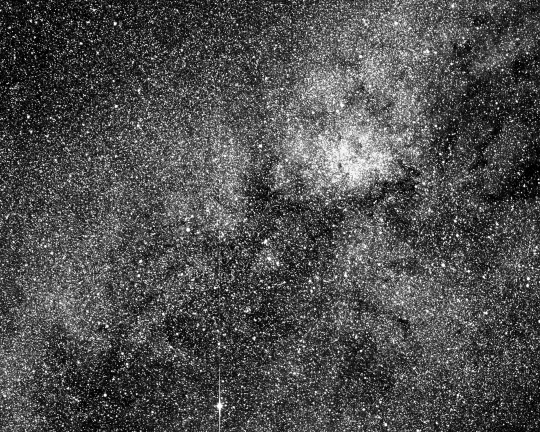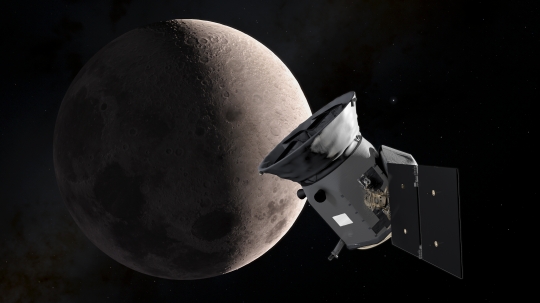I want to be sure to get the first image from TESS, the Transiting Exoplanet Survey Satellite, into Centauri Dreams, given the importance of the mission and the high hopes riding on it as the next step in exoplanet exploration. Now we move from the Kepler statistical survey methodology to a look at bright, nearby stars, and plenty of them. TESS will cover an area of sky far larger than the amount of sky we see in this image, which looks out along the plane of the galaxy from a perspective that matches southern skies on Earth.

Image: This test image from one of the four cameras aboard the Transiting Exoplanet Survey Satellite (TESS) captures a swath of the southern sky along the plane of our galaxy. TESS is expected to cover more than 400 times the amount of sky shown in this image when using all four of its cameras during science operations. Credits: NASA/MIT/TESS.
Showing some 200,000 stars, the image is centered on the southern constellation Centaurus, with a bit of the Coalsack Nebula at the upper right and, if you look along the bottom edge, the bright star Beta Centauri readily visible. Here I add the usual caution that Beta Centauri has nothing to do with Alpha Centauri — it is a separate place and interesting in its own right. About 400 light years out, this is, like Alpha Centauri, a triple system, and with Alpha Centauri, it serves as one of the pointer stars to the lovely asterism known as the Southern Cross.
While a triple system, Beta Centauri’s component stars are nothing like the G-class Centauri A, K-class Centauri B and M-dwarf Proxima Centauri. At Beta Centauri we have a close binary consisting of two B-class stars orbiting each other over a period of 357 days, both stars thought to be variables now evolving off the main sequence. Orbiting the binary is Beta Centauri B, another B-class star with an orbital period of between 125 and 220 years [see comments to this post for the revision I’ve made to the orbital period of this star].
This first TESS image is a test of the spacecraft’s four cameras, with a science-quality image expected to be released in June. Meanwhile, the spacecraft is easing into its highly elliptical orbit, with a final thruster burn scheduled for May 30. Science operations should commence in mid-June once orbital adjustments and camera calibrations are completed.

Image: An illustration of TESS as it passed the Moon during its lunar flyby. This provided a gravitational boost that placed TESS on course for its final working orbit. Credit: NASA’s Goddard Space Flight Center.
This first story on an operational TESS gives me echoes of New Horizons, which we followed here from launch to Pluto and now on to MU69 and whatever KBO may be next. Some people caution against anthropomorphizing machines, a human tendency when we deal with our pets, applying human perspectives to creatures considerably different than ourselves. To me the distinction is meaningless. We apply our passions and values to the things that matter to us, and New Horizons and TESS fit that bill for me. I recognize that spacecraft are not ‘creatures’ but my own values of commitment and purpose ride with these machines that can feel neither.



I also have high hopes for TESS and the many follow up observations its findings will lead to from the JWST and other observatories.
Just a trivial observation, for Beta Centauri B, the stated separation from Aa and Ab of 100k AU (1.6 ly) doesn’t jive with the claimed orbital period of 1500y. That would require an orbital velocity of ~2000km/s. :/
Yes you’re right this doesn’t make sense, this is a claim on Wikipedia that was not cited. A recent published estimate (below) gives in the region of 125 to 220 year orbital period for Beta Cen B and therefore much closer to the Beta Cen A pair. I’ve removed the claim from Wiki.
https://arxiv.org/abs/1602.02806
Good work, Sam, and thanks to you as well, John. I’m going to revise the post here to reflect this.
“To me the distinction is meaningless.”
Indeed. It is one’s perceptions of the world that shape one’s world-view; one’s sentience is extended to tools and machines one uses and projected onto other objects, sentient or insentient, wittingly or unwittingly. Efforts to stamp out anthroponorphism do nothing for the subliminal and unwitting tendencies. Humans see a world different from a deep-sea fish, a bat, or a mole rat, just considering vertebrates.
Awareness and acceptance of limitations is more realistic than denial and dismissal.
Soon TESS will peer into the unknown to gather information which will become known in about a year.
“This first New Horizons image” should be “This first TESS image”, I think.
Exactly so. Thanks.
One thing–Crux, more commonly called “The Southern Cross,” is a full-fledged constellation, not an asterism–at least according to “Skyguide: A Field Guide for Amateur Astronomers.” (But the IAU recently modified the official nomenclature of Alpha Centauri A & B and C, so I suppose Crux could have been downgraded as Pluto was.) The constellation Cygnus, “The Swan,” is sometimes called–informally–the northern cross, due to its appearance.
Wish a greater success for TESS after Kepler.
How good will TESS be at fast moving objects since it is above most all of the earth satellites? Since this is the first wide field survey, might it pick up some mysterious guest in our part of the galaxy?
Are any of the stars in the Beta Centauri system large enough to go supernova in the future?
Both components of Beta Cen A
To avoid confusion with Alpha Centauri (even Arthur C. Clarke, in “The Fountains of Paradise,” accidentally–in the first chapter about Starglider, the alien Bracewell probe–referred to “…the triple system of Alpha, Beta, and Proxima Centauri…”), it might be a good idea if Beta Centauri’s well-known ancient name “Agena” was used.
What uses could a Kardashev Type II Civilisation make of Beta Centauri?
Asking for a friend…
Beginning at about the 50-minute point in Carl Sagan’s “Cosmos,” in the episode–and in the chapter in the accompanying book–titled “Encyclopedia Galactica” (see: http://www.youtube.com/watch?v=m-NIwzBFJ_Y ), Sagan looks at an entry in the computerized encyclopedia, which is for a highly advanced civilization that uses the energy of O and B class giant blue stars, like those of the Beta Centauri system.
Here is the Cosmos episode in question online, so you can go to the Encyclopedia Galactica section and make a screengrab of the information:
http://www.dailymotion.com/video/x1h5p4k
The one with the superadvanced ETI is particularly interesting.
Speaking of satellites in the vicinity of the Moon…
Queqiao reaches intended orbit, Longjiang-2 images Moon
https://gbtimes.com/change-4-update-queqiao-relay-satellite-in-halo-orbit-longjiang-2-returns-amazing-images-from-moon
TESS starts small…
https://www.nasa.gov/feature/goddard/2018/nasa-s-planet-hunting-tess-catches-a-comet-before-starting-science